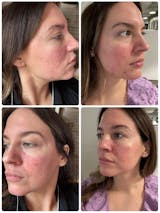
If you are having issues with oil control on acne prone skin, here are five steps to take in order to reduce oil production:
Step 1: Break the Oil Production Cycle
Your skin operates on a biofeedback loop whereby oil is produced only when it is necessary. When you have clogged pores, oil is trapped and cannot reach its intended target so neighboring pores go into overdrive in order to make up for oil that is lacking. This leads to more clogs forming.
Break the oil production cycle by decongesting your pores. Clear Out is very effective in flushing out existing clogs. Furthermore, it uses medical grade retinol which directly decreases oil production:
Step 2: Getting Cleansing Right
Opt for a gentle cleanser and only wash your face twice per day: once in the morning and once in the evening. If you find that your skin still skews oily, spend more time working in the gentle cleanser and you will find the right balance.
It is a common mistake for people with oil skin to use a strong cleanser, or to overwash. This will force your skin into overdrive to make up for lost oil. This cleanser has been perfectly balanced for those with oily skin:
Step 3: Getting Moisturizing Right
Your skin operates on a biofeedback loop. Moisturize proactively so that your skin does not need to generate oil to do the same job. Here is an oil-free moisturizer which you will find very useful:
Step 4: Watch Your Diet
Avoid foods that are high on the glycemic index (GI). These foods have been proven to trigger your sebum glands to produce more oil. Common foods include: baked potatoes, pasta, white rice, white bread and ice cream:

Step 5: Consider a Toner
Toners have gotten a bad rap for containing drying alcohol. However, not all toners are the same. Consider a toner that contains salicylic acid as this BHA will break down oils.
For More Questions ...
Please message us by clicking Send Message from our Facebook page or Instagram profile or by visiting this link: https://m.me/clearlybasics
Disclaimer:
Nothing on this article should be interpreted as personal medical advice. For medical related matters, please consult with your dermatologist.






